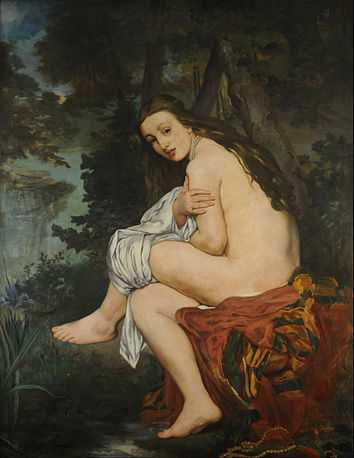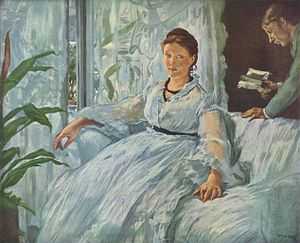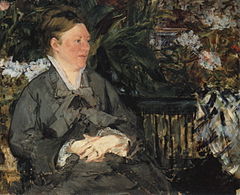Suzanne Manet

Suzanne Manet (US /mæˈneɪ/ or UK /ˈmæneɪ/; born Suzanne Leenhoff; 30 October 1829 in Delft – 8 March 1906 in Paris) was a Dutch-born pianist and the wife of the painter Édouard Manet, for whom she frequently modeled.
Suzanne

An excellent pianist, Leenhoff was initially hired in 1851 by Manet's father Auguste, as piano teacher for Édouard and his brothers. In their early twenties, Suzanne and Édouard developed a personal relationship and were romantically involved for approximately ten years. After Édouard left his parents' home he and Suzanne lived together, although they kept their relationship discreet and secret, especially from Édouard's father. She also may have been Auguste's mistress. In 1852, Leenhoff gave birth, out of wedlock, to a son, Leon Koella Leenhoff. Suzanne and Édouard were finally married in October 1863, a year after the death of Édouard's father.[1]
Eleven-year-old Leon Leenhoff, whose father may have been either of the Manets,[2] posed often for Édouard Manet. Most famously, he is the subject of the Boy Carrying a Sword of 1861 (Metropolitan Museum of Art, New York). He also appears as the boy carrying a tray in the background of The Balcony.[3]
Portrait by Degas

Édouard Manet and Edgar Degas met by chance at the Louvre in 1862, and after an intense conversation and Manet's demonstration on the art of etching, they became lifelong friends. Sometime in 1868 Degas painted a portrait of Manet and his wife. Manet is reclining on a couch and Suzanne appears to be seated at a piano. The mystery that surrounds the portrait by Degas is the fact that the painting has been slashed from top to bottom and right through the likeness of Suzanne. The supposition is that Manet, for an unknown reason, cut the painting. Manet might have slashed the painting because he didn't like the way Suzanne was painted, or because he was feuding at the time with Degas, or he might have been angry with his wife. When Degas saw what had been done to his painting he demanded its return, and he took it back. Degas intended to re-paint the likeness of Suzanne at the piano and he reiterated his intention to Ambroise Vollard in conversation with him around the turn of the century. Degas never got around to fixing the painting and it remains in its slashed state in the Kitakyushu Municipal Museum of Art in Japan. [4] [5]
Suzanne as a model
-

Édouard Manet, The Startled Nymph, 1859-1861
-

Édouard Manet, The Lecture, 1868
-

Édouard Manet, Madame Manet, Norton Simon Museum, 1874-1876
-
Édouard Manet, Mme. Manet in The Greenhouse, 1879
-

Édouard Manet, Mme. Manet, On A Blue Sofa, c. 1880
-

Édouard Manet, Mme Manet in the garden of Bellevue, 1880, Metropolitan Museum of Art
References
- ↑ Manet 1832-1883, Françoise Cachin, p286.
- ↑ Madame Édouard Manet (Suzanne Leenhoff, 1830–1906), Metropolitan Museum of Art
- ↑ Mauner, G. L., & Loyrette, H. Manet: the still-life paintings. New York: H.N. Abrams in association with the American Federation of Arts, 2000. p. 66. ISBN 0-8109-4391-3.
- ↑ Manet 1832-1883, Paul-André Lemoisne, pp140-142.
- ↑ NY Times, March 1992, ART; Degas and Mrs. Manet
Further reading
- Charles S. Moffet, Françoise Cachin in collaboration with Michel Melot: Manet 1832–1883. Réunion des Musées Nationaux, Paris, The Metropolitan Museum of Art, New York, Harry N. Abrams, Inc., New York 1983, ISBN 0-87099-349-6.
- Jean Sutherland Boggs, Henry Loyrette, Michael Pantazzi, Gary Tinterow, Degas, Réunion des Musées Nationaux, Paris, The Metropolitan Museum of Art, New York, National Gallery of Canada, Ottawa, New York 1988, ISBN 0-87099-520-0.
- A. van Anrooy: Impromptu Zaltbommel 1982 ISBN 90-288-1620-8
- Otto Friedrich: Edouard Manet und das Paris seiner Zeit Kiepenheuer & Witsch 1994 ISBN 3-462-02366-7
- Nancy Locke: Manet and the Family Romance Princeton University Press 2001 ISBN 0-691-05060-0
- Gotthard Jedlicka: Manet Zürich 1941
